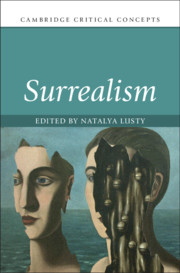Book contents
- Surrealism
- Cambridge Critical Concepts
- Surrealism
- Copyright page
- Contents
- Illustrations
- Notes on Contributors
- Acknowledgments
- Introduction: Surrealism’s Critical Legacy
- Part I Origins: Ideas/Concepts/Interventions
- Part II Developments: Practices/Cultures/Material Forms
- Part III Applications: Heterodoxies and New Worlds
- Chapter 14 Surrealism and Schizoanalysis
- Chapter 15 The Surrealist Bestiary and Animal Philosophy
- Chapter 16 Picasso’s Habits: André Breton on Art, Nature and Reflexivity
- Chapter 17 Surrealism and Mass-Observation
- Chapter 18 Pacific Surrealism
- Chapter 19 Decolonial Surrealism
- Chapter 20 Surrealism and écriture féminine
- Chapter 21 Subcultural Receptions of Surrealism in the 1960s International Underground Press
- Select Bibliography
- Index
Chapter 14 - Surrealism and Schizoanalysis
from Part III - Applications: Heterodoxies and New Worlds
Published online by Cambridge University Press: 23 July 2021
- Surrealism
- Cambridge Critical Concepts
- Surrealism
- Copyright page
- Contents
- Illustrations
- Notes on Contributors
- Acknowledgments
- Introduction: Surrealism’s Critical Legacy
- Part I Origins: Ideas/Concepts/Interventions
- Part II Developments: Practices/Cultures/Material Forms
- Part III Applications: Heterodoxies and New Worlds
- Chapter 14 Surrealism and Schizoanalysis
- Chapter 15 The Surrealist Bestiary and Animal Philosophy
- Chapter 16 Picasso’s Habits: André Breton on Art, Nature and Reflexivity
- Chapter 17 Surrealism and Mass-Observation
- Chapter 18 Pacific Surrealism
- Chapter 19 Decolonial Surrealism
- Chapter 20 Surrealism and écriture féminine
- Chapter 21 Subcultural Receptions of Surrealism in the 1960s International Underground Press
- Select Bibliography
- Index
Summary
This chapter critically reevaluates the Surrealist technique of splitting up and rearranging figures and dolls into mythopoetic concoctions, often featuring androgynous and machinic bodies. This tendency continues in contemporary art. At the root of these artistic experiments is a desiring imagination that reaches beyond “normal” bodies. This complements queer theories that aim to deconstruct, and see beyond, everyday heteronormativity. Deleuze and Guattari’s “schizoanalysis” also suggests that this process of splitting up is fundamentally creative and life affirming. Against traditional psychoanalysis, schizoanalysis looks to the example of the schizophrenic, who initiates a spontaneous creativity, splitting and reassembling normative codes and conventions. From the Greek, skhizein (“split”) and phrēn (“mind”), schizophrenia features the splitting of social and mental cohesion. The chapter suggests how it is possible to analyze this Surrealist process of ‘splitting’ using different levels of description: queer, schizoanalytical, and politico-aesthetic.
Keywords
- Type
- Chapter
- Information
- Surrealism , pp. 259 - 271Publisher: Cambridge University PressPrint publication year: 2021

